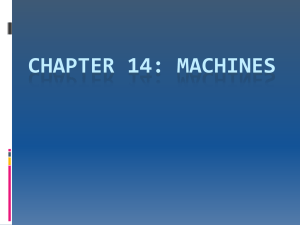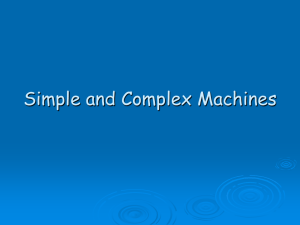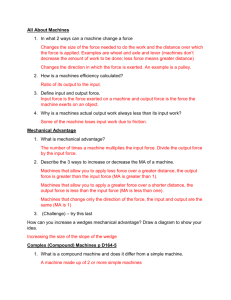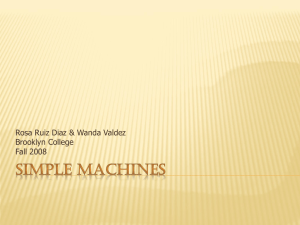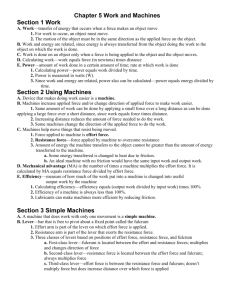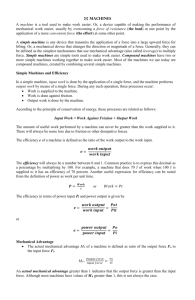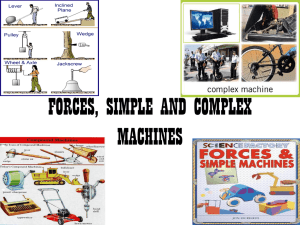Types of Simple Machines
advertisement
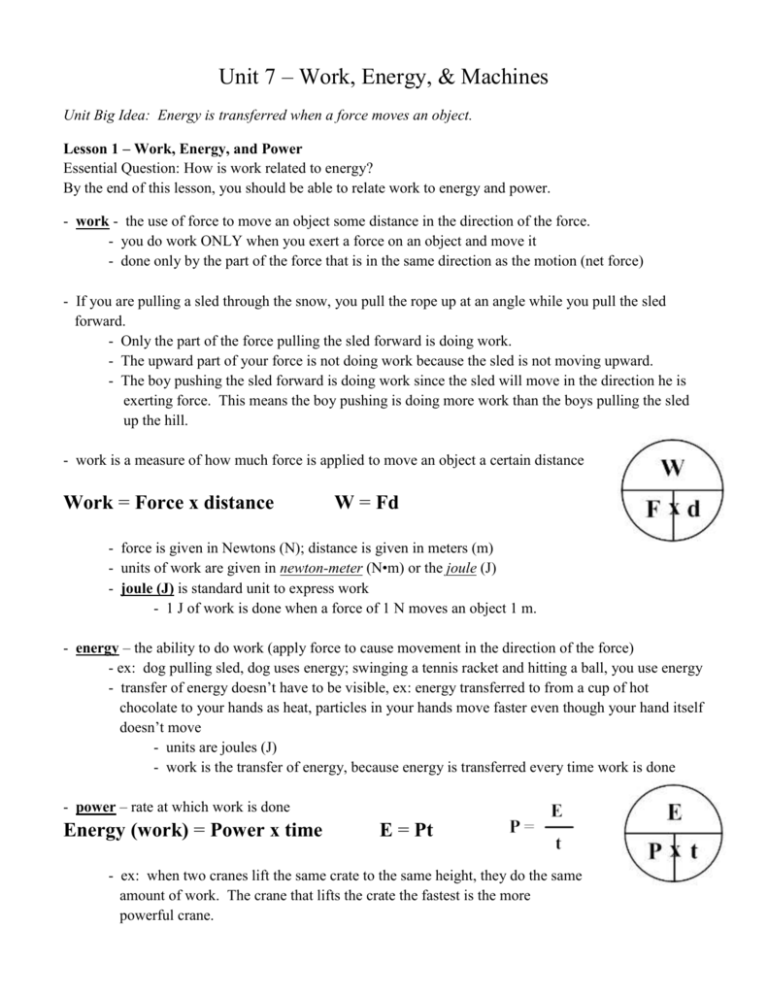
Unit 7 – Work, Energy, & Machines Unit Big Idea: Energy is transferred when a force moves an object. Lesson 1 – Work, Energy, and Power Essential Question: How is work related to energy? By the end of this lesson, you should be able to relate work to energy and power. - work - the use of force to move an object some distance in the direction of the force. - you do work ONLY when you exert a force on an object and move it - done only by the part of the force that is in the same direction as the motion (net force) - If you are pulling a sled through the snow, you pull the rope up at an angle while you pull the sled forward. - Only the part of the force pulling the sled forward is doing work. - The upward part of your force is not doing work because the sled is not moving upward. - The boy pushing the sled forward is doing work since the sled will move in the direction he is exerting force. This means the boy pushing is doing more work than the boys pulling the sled up the hill. - work is a measure of how much force is applied to move an object a certain distance Work = Force x distance W = Fd - force is given in Newtons (N); distance is given in meters (m) - units of work are given in newton-meter (N•m) or the joule (J) - joule (J) is standard unit to express work - 1 J of work is done when a force of 1 N moves an object 1 m. - energy – the ability to do work (apply force to cause movement in the direction of the force) - ex: dog pulling sled, dog uses energy; swinging a tennis racket and hitting a ball, you use energy - transfer of energy doesn’t have to be visible, ex: energy transferred to from a cup of hot chocolate to your hands as heat, particles in your hands move faster even though your hand itself doesn’t move - units are joules (J) - work is the transfer of energy, because energy is transferred every time work is done - power – rate at which work is done Energy (work) = Power x time E = Pt - ex: when two cranes lift the same crate to the same height, they do the same amount of work. The crane that lifts the crate the fastest is the more powerful crane. - power is the rate at which energy is converted from one form to another - units of power are watts (W) - 1 watt = 1 joule per second (J/s) Lesson 2 Kinetic and Potential Energy Essential Question: What are kinetic and potential energy? By the end of this lesson, you should be able to calculate kinetic and potential energy and know how these two types of energy are related. - kinetic energy – energy of motion - every moving object has kinetic energy - ex: a hammer has kinetic energy when it moves towards the nail; when the hammer hits the nail, the energy is transferred to the nail; work is done when the nail is driven into the wood because the movement of the nail is in the direction of the force applied by the hammer - the faster an object moves, the more kinetic energy it has - kinetic energy depends on speed and the mass of the object moving - if two object move at the same speed, the one with more mass with have more kinetic energy - m = mass of the object - v = object’s speed - kinetic energy units are joules (J) - potential energy – energy of an object has because of its position, condition, or chemical composition - ability to do work - elastic potential energy when stretched or compressed (rubber band or spring) - gravitational potential energy due to position above the ground - mechanical potential energy depends on an object’s position - chemical potential energy is due to its chemical bonds that is released in chemical reactions gravitational potential energy = mass x gravity x height - GPE = mgh m = object’s mass g = acceleration due to Earth’s gravity which is always 9.8 m/s2 h = object’s height from the ground potential energy units are joules (J) - mechanical energy – energy possessed by an object due to its motion and position (KE & PE) mechanical energy = kinetic energy + potential energy ME = KE + PE - If an object’s only potential energy is gravitational potential energy, the equation below is used to find its mechanical energy Lesson 3 – Machines Essential Question: How do simple machines work? By the end of this lesson, you should be able to describe different types of simple machines and to calculate the mechanical advantages and efficiencies of various simple machines. - machine – any device that helps people do work by changing the way work is done. - simple machines make up other machines; 6 types: - levers, wheels and axles, pulleys, inclined planes, wedges, & screws - work is the use of force to move an object some distance - input force - the force you apply to a machine through a distance - work input – work you do on a machine - ex: you do work on a wheelbarrow when you lift the handles; by pulling up the handles you make it move - work output – work done by the machine - ex: wheelbarrow moving the logs - output force – force a machine exerts on an object - wheelbarrow exerts an output force on the logs to lift them up - machines make tasks easier without decreasing the amount of work done - Work = Force x distance W = Fd - if you apply less force through a machine, you apply it over a longer distance = amount of work done is still the same - ramp is an example of a machine that can change the magnitude (size) of the force needed to move an object - you apply less force when you push a barrel up a ramp than when you lift the barrel. - you apply the force over a longer distance so the amount of work you do is the same for when you lift the barrel to the same height or roll it up a ramp - some machines increase the amount of force needed but you apply the force over a shorter distance - some machines change the way you do work by changing the direction of a force - you pull down on the rope to raise the flag on flagpole - the rope runs over a pulley at the top of the flagpole - the rope exerts an upward force on the flag causing the flag to go up - the direction of the force you applied has changed since you’re pulling down and the force is pulling up - the magnitude (size) of the force and distance you apply the force stay the same - some machines can change the direction of a force, magnitude (size) of a force, & the distance the force is applied. - mechanical advantage – number of times the machine multiplies the input force - way to compare input force with the output force - ignoring friction, you can calculate mechanical advantage (MA) of any machine by dividing the output force by the input force - machine with a mechanical advantage greater than ONE (1) multiplies the input force producing greater output force - MA > 1 gives greater output force - example: bottle opener opening a soda (input force – you hand lifting up; output force – bottle opener lifting soda cap up) - machine with a mechanical advantage equal to ONE (1) changes only the direction of the force - MA = 1 changes direction of force - example: pulley lifting a box (input force – pulling down on rope; output force – rope pulling box upwards) - machine with a mechanical advantage less than ONE (1) requires greater input force, but the output force is applied over a longer distance - MA < 1 needs more input force but over longer distance - example: hammer hitting a nail (input force – you hitting the hammer into the nail; output force – nail moving into the board) - mechanical efficiency – comparison of a machine’s work output with the work input. - Some of the work done by a machine is done to overcome friction Types of Simple Machines: Levers - Lever - simple machine that has a bar that pivots at a fixed point - examples: hammers, seesaws, baseball bats - used to apply force to move an object - load – force of the object - 3 classes of levers based on the positions of the fulcrum, load, and input force - fulcrum – fixed point of a lever - ideal mechanical advantage – mechanical advantage of a simple machine that does not take friction into account - mechanical advantage of a machine that is 100% efficient - ideal mechanical advantage of a lever is equal to the distance for input force to fulcrum (dinput) divided by the distance from output force to fulcrum (doutput) - If a lever has a mechanical advantage of greater than 1 (ME > 1), the fulcrum is closer to the load than to the input force. The output force is larger than the input force, but it is applied through a shorter distance. - If the lever has a mechanical advantage of 1 (ME = 1) , the fulcrum is exactly in the middle of the lever. The direction of the force is changed, but the distance and magnitude (size) of the input force and output force are the same. - If the lever has a mechanical advantage of less than 1 (ME < 1), the fulcrum is closer to the input force than the load. The output force is less than the input force, but it is applied through a longer distance. 1st Class Lever: - the fulcrum is between the input force and the load always change the direction of the input force may also increase the force or the distance through which the force is applied the ideal mechanical advantage can be greater than one, one, or less than one depending on the location of the fulcrum - example: seesaw, scissors 2nd Class Lever: - load is between the fulcrum and the input force do not change the direction of the input force allow you to apply less force than the load but over a greater distance ideal mechanical advantage is always greater than one examples: wheelbarrow, bottle-cap opener, stapler 3rd Class Lever: - input force is between the fulcrum and the load do not change the directions of the input force mechanical advantage is always less than one output force is less than the input force but output force is applied over a longer distance examples: hammers, baseball bats Types of Simple Machines: Wheel and axle - wheel and axle – simple machine made of a wheel connected to as smaller cylindrical object, the axle - examples: doorknobs, tires, screwdrivers, pencil sharpeners, water faucet - ideal mechanical advantage of a wheel and axle equals the radius corresponding to the input force divided by the radius corresponding to the output force - The radius of the wheel is always larger than the radius of the axle. - mechanical advantage is greater than one when the input force is applied to the wheel, such as when you turn on a faucet - mechanical advantage is less than one when the input force is applied to the axle, such as when a Ferris wheel is turned - The axle of the faucet turns when an input force is applied to the wheel. The axle rotates through a shorter distance than the wheel does so the output force is larger than the input force. Types of Simple Machines: Pulley - pulley – simple machine that has a grooved wheel that holds a rope or a cable - the load is attached to one end of the rope and the input force is applied to the other end - 3 types of pulleys: fixed, movable, & block and tackle Fixed Pulleys - attached to something that does not move allows you to pull down on the rope to lift the load up the wheel of the pulley turns and changes the direction of the force do not change the magnitude (size) of the force size of the output force is the same as the size of the input force has an ideal mechanical advantage of 1 Movable Pulleys - wheel is attached to the object being moved and one end of the rope is fixed you pull on the other end of the rope to make the wheel and load move along the rope moves up with the load as the load is lifted do not change the direction of a force, but does increase the force ideal mechanical advantage is 2 increase the distance through which the input force must be applied – the rope must be pulled twice the distance that the load is moved Block and Tackle Pulleys - made by combining a fixed pulley and a movable pulley used by cranes at construction sites to lift heavy objects change the direction of the force and increase the force ideal mechanical advantage depends on the number of rope segments - if it has 4 ropes then MA = 4; this means that it multiplies the input force by 4 but you have to pull the rope 4 times as far Types of Simple Machines: Inclined Plane - inclined plane – simple machine that is a straight, slanted surface - a smaller input force is needed to move an object using an inclined plane than is needed to lift the object but the force is applied over a longer distance - amount of work is the same, just over a longer distance - ideal mechanical advantage is calculated by dividing the length of the incline by the height the load is lifted Types of Simple Machines: Wedge - wedge – pair of inclined planes that move - have one thick end and one thin end - used to cut and split objects - the output force is greater than the input force but the output force is applied over a shorter distance - the longer and thinner the wedge is, the greater the ideal mechanical advantage - examples: chisels, ax heads, knife blades, door stops Types of Simple Machines: Screw - screw - inclined plane that is wrapped in a spiral around a cylinder - when a screw is turned, a small force is applied through the distance along the inclined plane of the screw - screws apply a large force through the short distance it is pushed - the longer the spiral on a screw is and the closer together the threads are, the greater the screw’s mechanical advantage Simple Machines vs. Compound Machines Simple Machines • Made with few or no moving parts • Examples: - wagon wheel (wheel) - seesaw (lever) - saw (wedge) Compound Machines • Made of 2 or more simple machines • Machines make work easier • Use a force to cause motion • Examples: - scissors (lever + wedge) - wheelbarrow (wheel + lever) - drill (wheel + screw + wedge)

